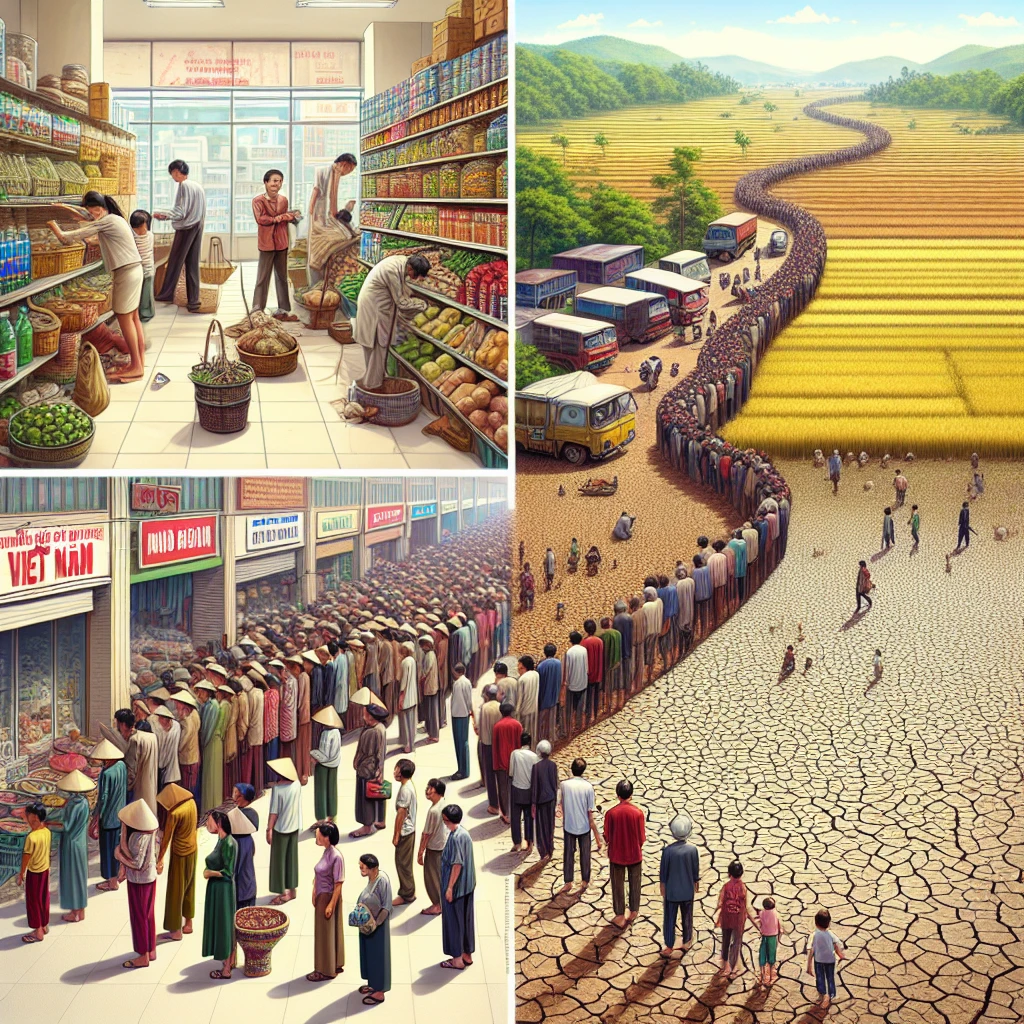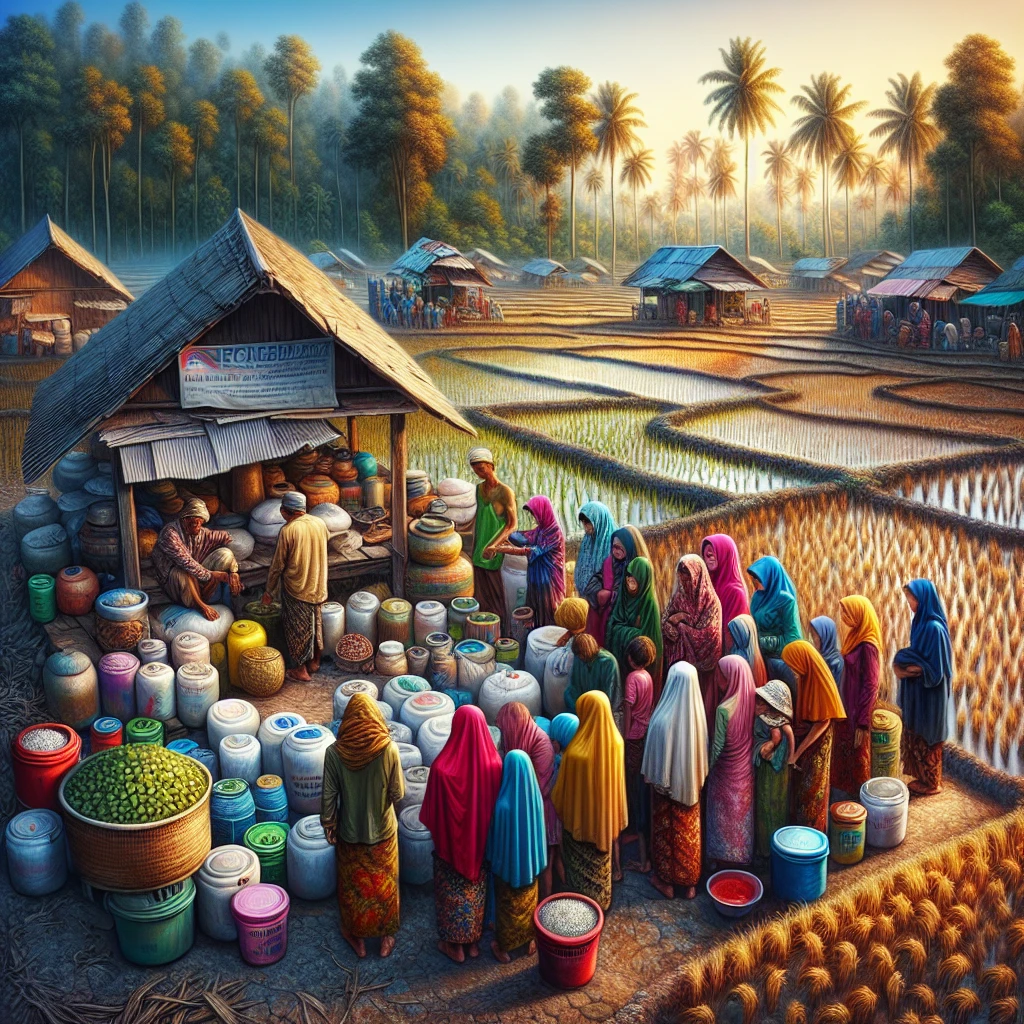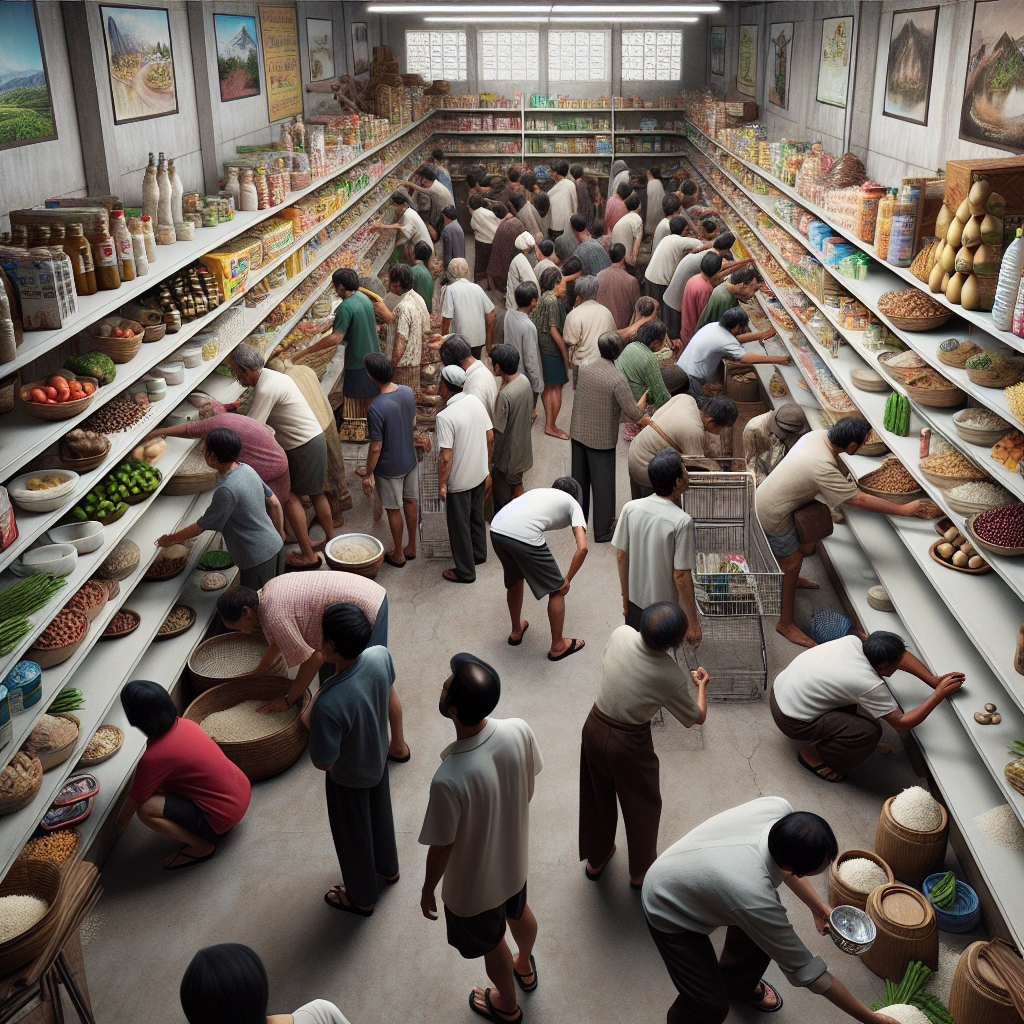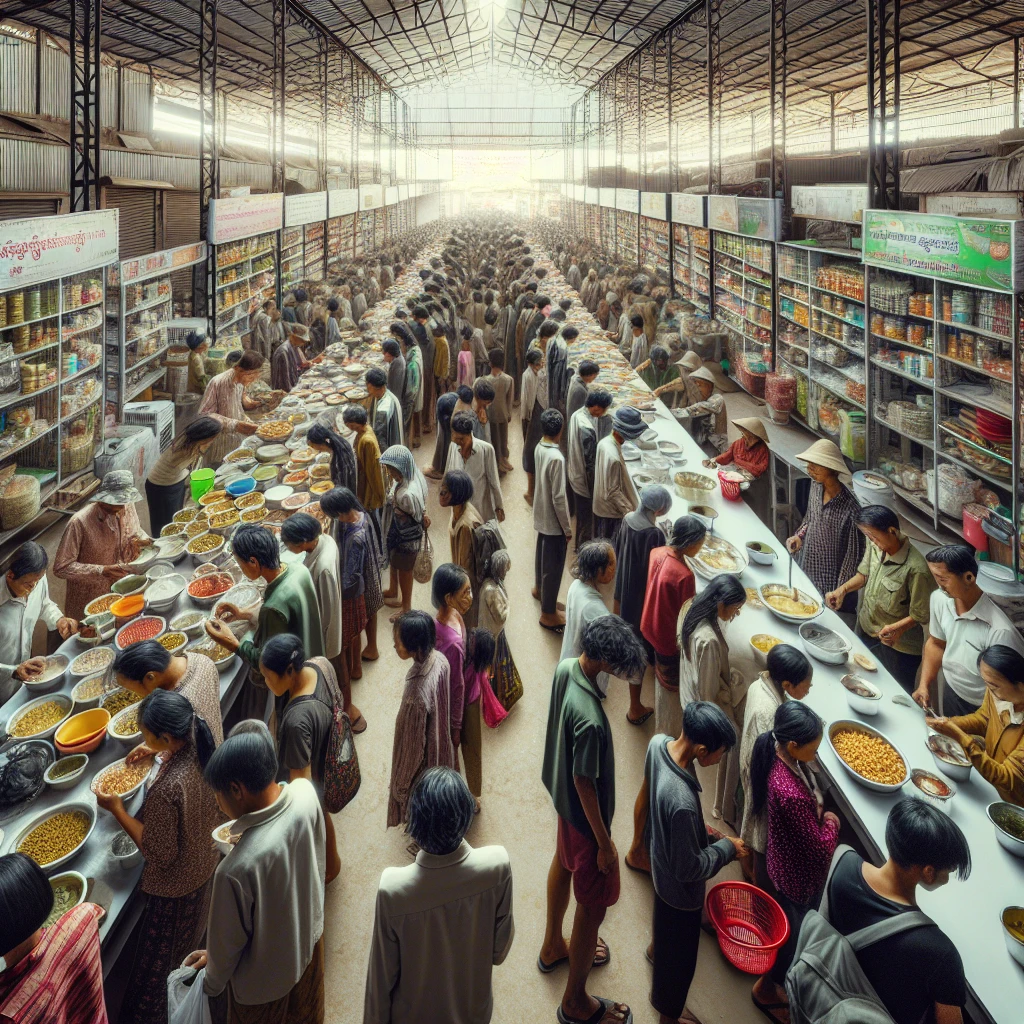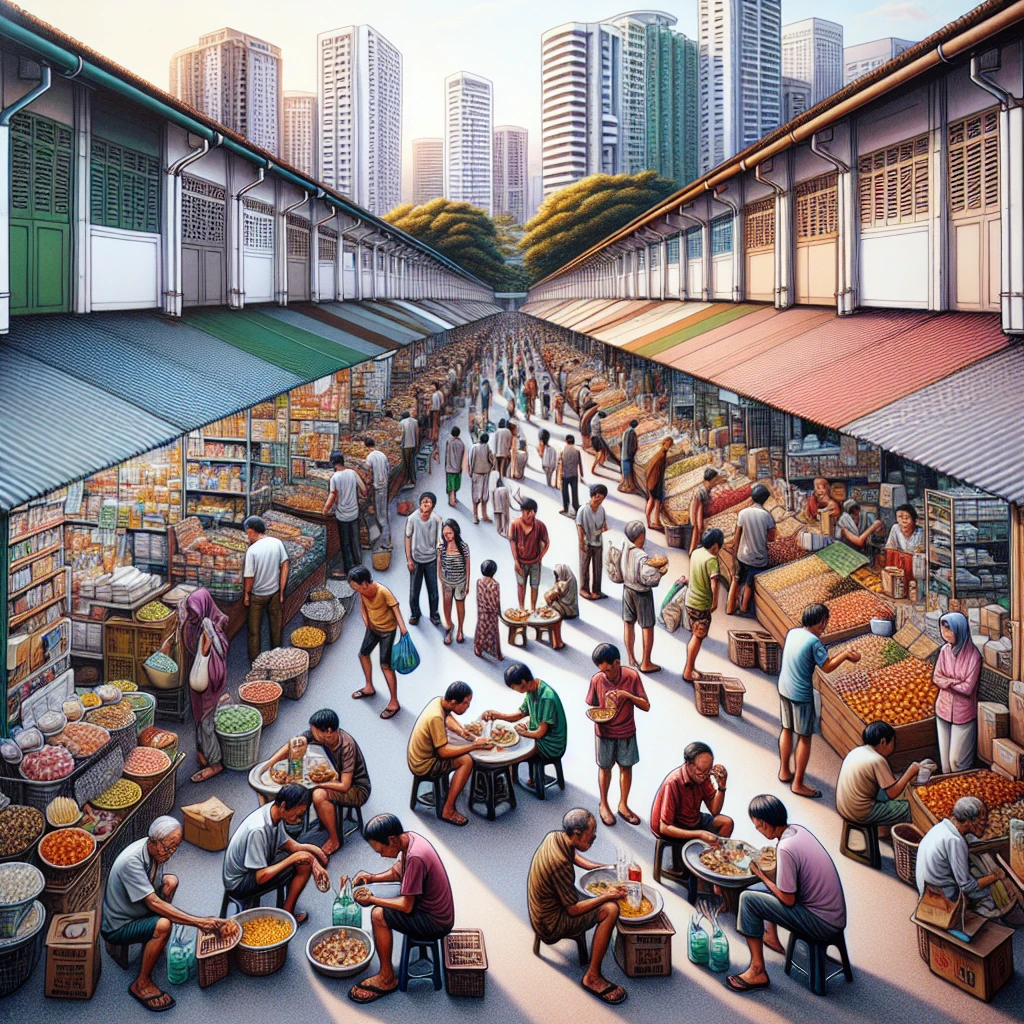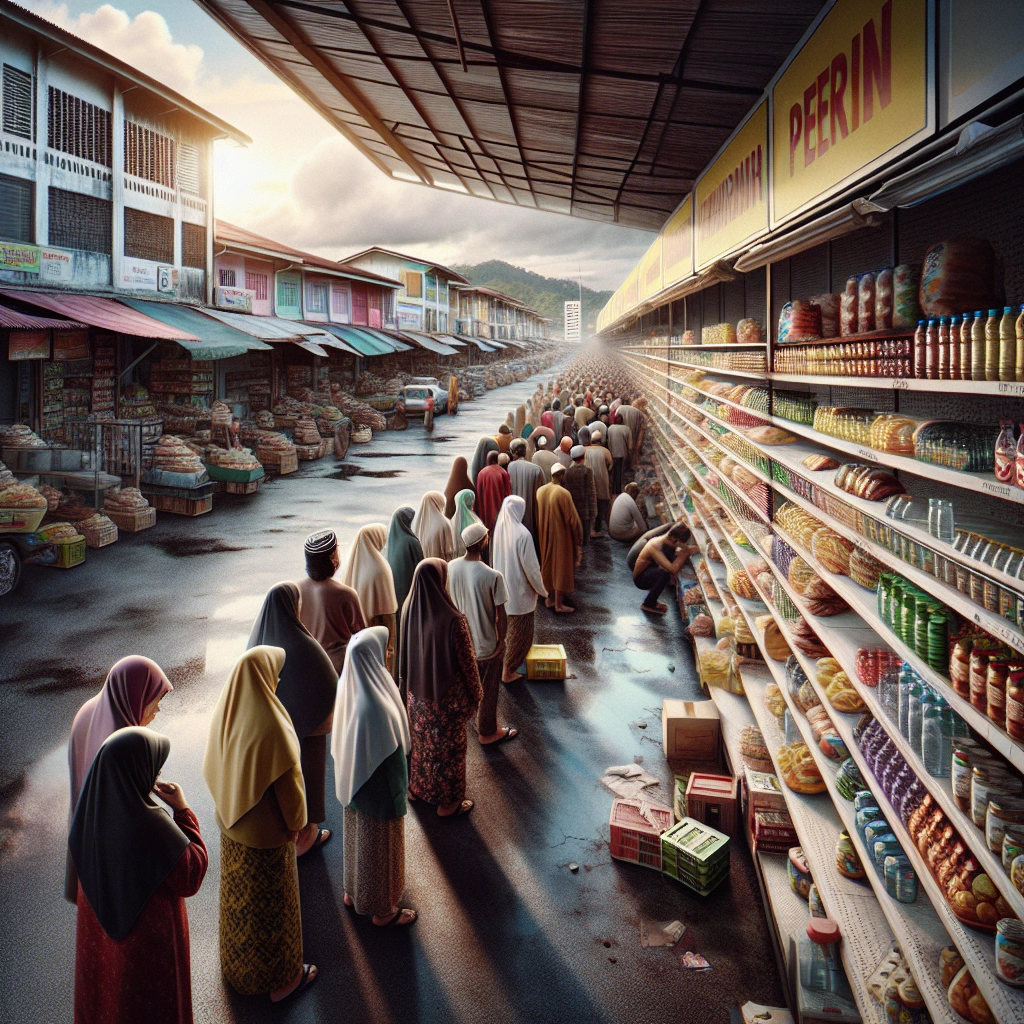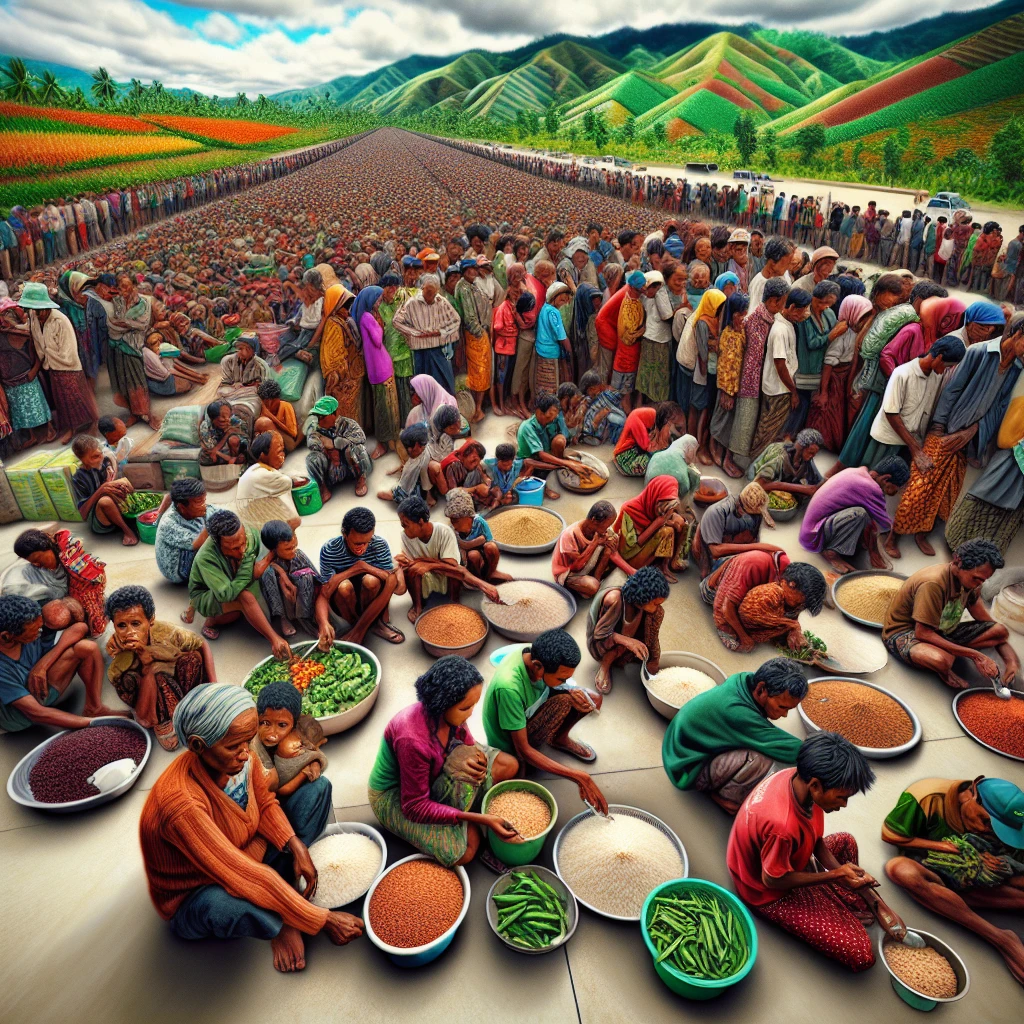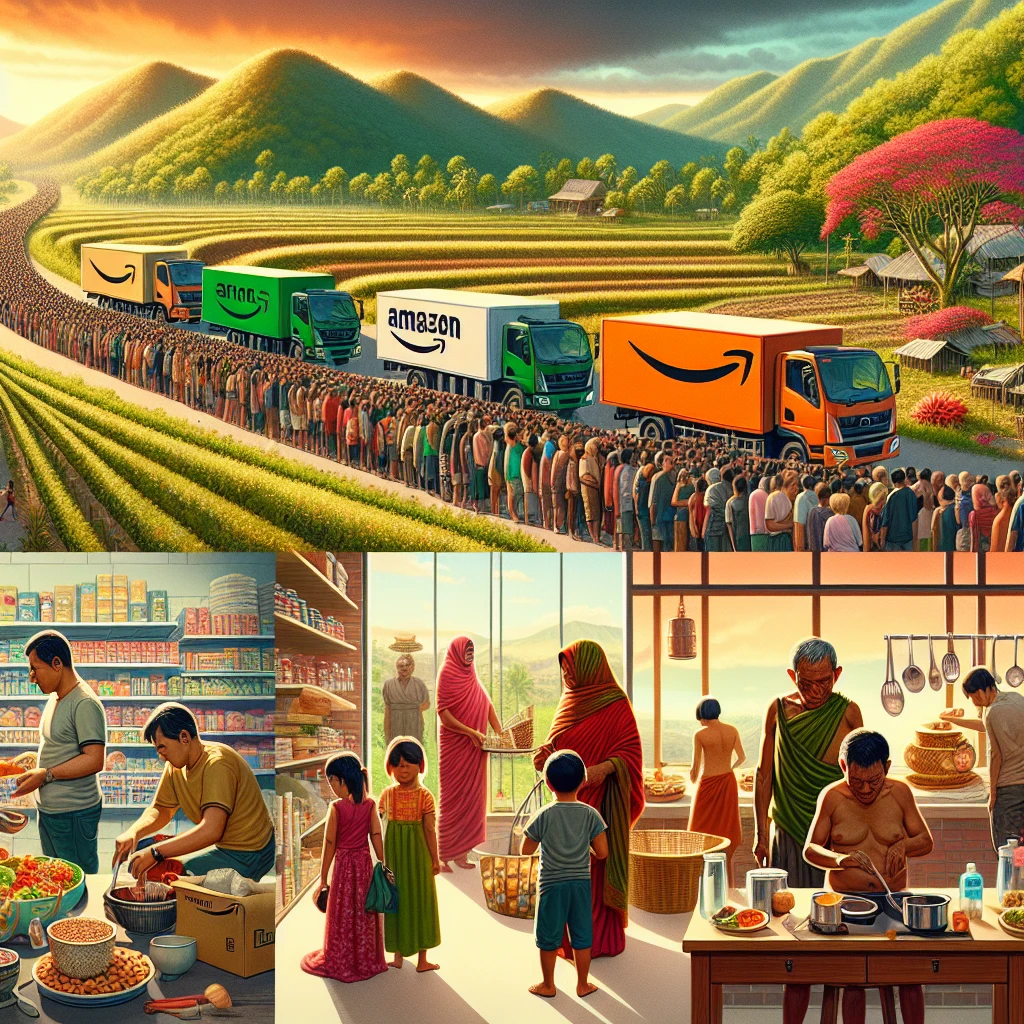

In 2023, Southeast Asia experienced food shortages due to factors such as heat waves, trade restrictions, and limited import of fertilizers and pesticides. These shortages have led to declining yields and contributed to food insecurity in the region.
The impact of the food shortages in Southeast Asia has been significant, with a large percentage of the population facing moderate or severe food insecurity. Children from poor families and rural areas have been particularly affected, with many suffering from stunted growth.
The region’s dependency on wheat imports and the global food crisis have also worsened the situation.
As a result of extreme weather conditions and trade restrictions, countries in Southeast Asia are grappling with the destruction of livelihoods, social displacement, and the loss of a significant amount of food. These challenges have underscored the need for key steps towards food security in the region and highlighted the progress, challenges, and future of food security in Southeast Asia.
Factors Leading to Food Shortages
Effects of climate change
Climate change, with its accompanying rise in global temperatures, extreme weather events, and disruptions in precipitation patterns, has significantly impacted food production in Southeast Asia. The increased frequency of heatwaves, droughts, floods, and wildfires has made it exceedingly challenging for farmers to cultivate crops and maintain food supplies.
Additionally, rising temperatures contribute to spoilage and contamination of food, further exacerbating the food shortages in the region.
Political instability and conflict
Political instability and ongoing conflicts have played a detrimental role in exacerbating the food shortages across Southeast Asia in 2023. The inequitable distribution of food, widespread poverty, and political unrest have all disrupted access to essential resources and perpetuated food insecurity. These factors have compounded the challenges faced by the population, posing significant obstacles to ensuring consistent and adequate food supplies.
Economic challenges in the region
The economic challenges in Southeast Asia have contributed to the exacerbation of food shortages in 2023. Soaring prices for food and fertilizers, combined with climate-induced production disruptions, have created a perfect storm for a hunger crisis of unprecedented proportions. The impact of economic shocks, coupled with the escalating climate shocks, has further deepened the existing food insecurity within the region.
Lack of access to resources and technology
Despite advancements in technology, the lack of access to essential resources and modern agricultural practices has hindered efforts to address food shortages in Southeast Asia. The limited access to vital resources such as water, arable land, and efficient farming techniques has impeded the region’s ability to sustainably produce and distribute food.
Moreover, the lack of technological advancements in agriculture has limited productivity, further aggravating the food scarcity in the region.
| Climate Change Effects | Political Instability and Conflict | Economic Challenges | Lack of Access to Resources and Technology |
|---|---|---|---|
| Rise in global temperatures, extreme weather events, and disruption in precipitation patterns impact food production. | Inequitable food distribution, poverty, and political unrest disrupt access to food. | Soaring prices for food and fertilizers, coupled with production disruptions, create a hunger crisis. | Limited access to vital resources and modern agricultural practices hinders sustainable food production. |
In essence, the confluence of climate change, political instability, economic challenges, and limited access to resources and technology has significantly contributed to the food shortages experienced in Southeast Asia in 2023. These complex and interconnected factors demand comprehensive solutions and strategic interventions to address the pressing issue of food insecurity within the region.
Vietnam
Current status of food shortages
In Vietnam, food shortages are a significant concern, with a World Bank survey revealing that 33% of households are worried about having enough food. Droughts since 2016 have led to agricultural losses, exacerbating food insecurity.
Furthermore, the increased food prices since 2021 have worsened the situation, impacting the accessibility of food for the population.
Efforts to address the issue
Vietnam has initiated the Zero Hunger Program, aiming to reduce malnutrition rates in children and eradicate hunger by 2025. To achieve this, the country encourages farmers to collaborate with cooperatives and food production chains. The government has also passed resolutions focusing on terminating food shortages and hunger by specific timelines, such as 2012 and increasing food production significantly by 2020.
Impact on the population
The prevalent food shortages and insecurity are likely to have adverse effects on the population, leading to increased vulnerability to malnutrition and health issues. Additionally, the economic aspect is affected due to reduced access to affordable and adequate food options, impacting the overall well-being of the citizens.
Philippines
Current status of food shortages
The current status of food shortages in the Philippines is alarming, with nearly 51 million Filipinos facing moderate or severe food insecurity in 2020 to 2022. According to a United Nations report, one out of ten households in the Philippines are food insecure, and the poorest regions have been more affected. This has led to a prevalent use of livelihood coping strategies among seven out of ten households to address food insecurity issues. The situation is worsened by malnutrition, particularly vitamin and mineral deficiencies, affecting the population.
Initiatives to combat food scarcity
In response to the dire food scarcity situation, various initiatives have been undertaken to combat the issue in the Philippines. Non-profit organizations and local government bodies have been actively involved in distributing food aid and implementing sustainable agricultural programs to ensure food security.
Additionally, educational campaigns have been launched to raise awareness about proper nutrition and farming techniques, with a focus on addressing malnutrition and vitamin deficiencies among the population.
Challenges in addressing food shortages
Addressing food shortages in the Philippines poses significant challenges due to the country’s geographical complexity, being an archipelago of over 7,600 islands. Accessibility and distribution of food resources remain a major challenge, especially in remote or impoverished areas.
Moreover, the impact of natural disasters, climate change, and the rising cost of fuel further exacerbate the existing food scarcity challenges, making it difficult to ensure consistent and equitable access to food across the nation.
| Challenges |
|---|
| Geographical complexity |
| Accessibility and distribution |
| Impact of natural disasters and climate change |
| Rising cost of fuel |
The Philippines is resilient, and despite these challenges, the nation continues to strive towards finding sustainable solutions to combat food shortages and ensure the well-being of its people.
Myanmar
Impact of political unrest on food security
The political unrest in Myanmar has significantly impacted food security, leading to a rise in food insecurity and poverty. Since the military takeover in February 2021, hunger levels in Myanmar have sharply risen, driven by the ongoing political crisis, poverty, displacement, and the economic fallout from COVID-19. The coup has strained supply chains, resulting in increased commodity prices and restricted access to food, exacerbating the food shortage crisis.
Efforts to alleviate food shortages
Efforts have been made to alleviate food shortages in Myanmar, with organizations like the World Food Programme (WFP) scaling up food distribution in urban areas for 2 million people in Yangon and Mandalay. Additionally, WFP has provided essential nutrition support for vulnerable groups, including children, pregnant and nursing mothers, as well as HIV and tuberculosis patients, to strengthen their immune systems.
These efforts aim to address the immediate food needs of the affected population.
Humanitarian crisis and its impact on food availability
The humanitarian crisis in Myanmar has had a profound impact on food availability, with over 13 million people facing severe hunger and more than 1 million individuals displaced from their homes. The triple impact of pre-existing poverty, the economic repercussions of COVID-19, and the political crisis has intensified hunger and the need for humanitarian assistance across the country.
The Food and Agriculture Organization (FAO) and other organizations continue to work towards addressing the growing complexity and severity of the food security crisis in Myanmar.
| Efforts to Alleviate Food Shortages |
|---|
| WFP scaled up food distribution in urban areas for 2 million people in Yangon and Mandalay. |
| WFP provided nutrition support for 70,000 vulnerable individuals, including children and pregnant mothers. |
| Over 13 million people are facing severe hunger, while more than 1 million have been displaced from their homes. |
These efforts reflect the dire situation that Myanmar is facing, and the need for continued support and intervention to mitigate the impact of the ongoing crisis on food security.
Indonesia
Factors contributing to food shortages
The factors contributing to food shortages in Indonesia include income reduction, disruptions to food delivery systems, and lack of affordability of diverse and nutritious diets. These have led to a triple burden of malnutrition, affecting a significant proportion of the population.
Additionally, the country’s struggle to achieve food self-sufficiency due to persistent problems in agriculture has exacerbated the food shortages.
Government interventions to address food scarcity
The Indonesian government has implemented interventions to address food scarcity, such as implementing policies to promote food security and self-sufficiency. Efforts have been made to improve the affordability and availability of diverse and nutritious diets, as well as to strengthen agricultural practices to enhance food production.
Resilience of the population in the face of food insecurity
Despite the challenges, the population in Indonesia has shown resilience in the face of food insecurity. Initiatives at the community level, such as local food security programs and support systems, have played a vital role in helping individuals and families cope with food shortages.
Moreover, the implementation of sustainable and resilient agricultural practices has contributed to mitigating the impact of food insecurity on the population.
| Food Security Measures | Description |
|---|---|
| Agricultural Policies | Implementation of policies to promote food security and self-sufficiency. |
| Community Initiatives | Local food security programs and support systems at the community level. |
These efforts have helped in building a level of resilience that has enabled the population to navigate and withstand the challenges posed by food insecurity.
Thailand
Overview of food shortages in the country
Thailand has been facing food shortages due to various challenges, including the impact of climate change, natural disasters, and water scarcity. These factors have contributed to a growing severity of food insecurity, posing significant threats to the nation’s agricultural production and food supply.
Strategies for improving food security
To address these challenges, Thailand has implemented strategic frameworks for food management, emphasizing cooperation among government, private, and civil society sectors. The vision is to achieve safe and high-quality food production to mitigate food shortages.
Additionally, agricultural development focused on increasing productivity and incomes is a key strategy to enhance national and household food security.
Role of agriculture and food production in mitigating shortages
Agricultural development plays a crucial role in mitigating food shortages in Thailand. By prioritizing productivity and income growth, the country aims to enhance food security at both national and household levels.
Strengthening the agricultural sector and ensuring sustainable food production are essential components in alleviating the impact of food shortages on the population.
| Challenges | Strategies |
|---|---|
| Climate Change | Strategic food management frameworks |
| Natural Disasters | Agricultural development |
| Water Scarcity | Cooperation among sectors |
Thailand is actively addressing food shortages through a multi-dimensional approach focused on strategic frameworks, agricultural development, and collaborative efforts across sectors.
Cambodia
Analysis of food shortages in the country
Cambodia faces critical challenges in food security and nutrition due to various factors such as climate change-induced impacts on agriculture, inefficient food systems, and undernutrition. The vulnerability of Cambodian farmers to changing weather patterns and extreme events further exacerbates the food shortages in the country, leading to a significant impact on the population’s well-being.
Government initiatives to address food insecurity
The Royal Government of Cambodia has undertaken various policy measures to address food security and nutrition within the country. Their commitment to improving the food security and nutrition situation is evident through the implementation of territorial approaches and policies aimed at enhancing the overall food environment and combating food insecurity.
Impact of food shortages on vulnerable populations
The population in Cambodia, especially children, faces the severe impact of food shortages, leading to issues like child malnutrition primarily caused by factors such as lack of education, cultural beliefs, food insecurity, and recurrent diarrhea. These vulnerabilities highlight the urgent need for comprehensive interventions to mitigate the adverse effects on the most susceptible segments of the society.
| No. | Point of Analysis | Details |
|---|---|---|
| 1. | Challenges in Food Security | Climate change impacts, inefficient food systems, and undernutrition |
| 2. | Government Policies | Territorial approaches, policies for enhancing food security and nutrition |
| 3. | Impact on Vulnerable Populations | Child malnutrition, cultural beliefs, and food insecurity leading to recurrent issues |
Laos
Challenges in ensuring food security
The geographical location and mountainous terrain of Laos present significant challenges in ensuring food security. The absence of adequate infrastructure, including road networks, makes it difficult to access both domestic and international markets, leading to limited food availability for the population.
Extreme weather events, such as floods and droughts, further exacerbate the situation by causing crop destruction and livestock loss, impacting the country’s food security.
Efforts to improve access to food
Efforts to improve access to food in Laos are focused on enhancing infrastructure such as roads, irrigation systems, and storage facilities. These improvements are crucial for facilitating farmers’ access to markets and reducing post-harvest losses.
Additionally, organizations like the World Food Programme (WFP) have been working in partnership with the Government of Laos to promote access to nutritious food for school-age children, contributing to the overall improvement of food access in the country.
International assistance in addressing food shortages
The international community has played a significant role in addressing food shortages in Laos. The WFP, in collaboration with the Government of Lao PDR, has launched initiatives to provide essential food assistance to families during times of food shortages.
Such assistance includes distributing rice to meet essential food needs for a specified duration, effectively mitigating the impact of food shortages on vulnerable populations.
| Country | Initiative | Impact |
|---|---|---|
| Laos | WFP’s partnership with Lao PDR promoting food access | Improved access to nutritious food |
These collaborative efforts reflect the commitment of international organizations to support the Lao Government’s vision of a prosperous country, free from food insecurity and poverty.
Remember, folks, we’re making great strides in addressing food shortages in Laos, and with continued efforts and support, positive impact can be achieved!
Malaysia
The current food scarcity situation in Malaysia is a matter of growing concern, with the country facing increased food insecurity due to various factors such as reliance on food imports, supply chain disruptions, and price fluctuations in the global market. The 2022 Global Hunger Index indicated a moderate score for hunger in Malaysia, reflecting a rise in food insecurity, particularly exacerbated by the ongoing pandemic.
Government policies to tackle food shortages
The Malaysian government has implemented comprehensive measures to address food shortages, focusing on four key pillars outlined by the Food and Agriculture Organization (FAO). These initiatives align with the National Food Security Policy Action Plan 2021-2025 and the National Agro-Food Policy 2021-2030 (DAN 2.0).
Additionally, the government has developed the National Agrofood Policy 2.0 (2021-2030) to specifically target food security challenges.
Socioeconomic impact of food insecurity
The socioeconomic repercussions of food insecurity in Malaysia are multifaceted, affecting psychological well-being, dietary intake, nutritional status, and health outcomes, especially in low-income urban households. It also contributes to the rising burden of non-communicable diseases, highlighting the urgent need to rehabilitate food systems and address the root causes of food insecurity.
Singapore
Examination of food supply chain issues
Singapore is heavily reliant on food imports, with over 90% of its food being brought in from more than 170 countries and regions. This makes the city-state particularly susceptible to supply chain disruptions and price volatility.
The country faces challenges such as food safety issues in the countries of origin, protectionist policies in food-producing nations prioritizing domestic needs, and the impact of climate change on food production.
Measures to ensure food availability
To bolster food availability, Singapore has adopted a multi-pronged strategy known as the “three food baskets.” This approach involves diversifying food sources, increasing local food production, and growing food overseas. Additionally, the country has implemented measures such as stockpiling essential food items and promoting local agricultural practices through innovative technologies like vertical farming, aquaponics, and food waste management.
Role of technology in addressing food shortages
Technology plays a pivotal role in addressing food shortages in Singapore. The city-state has embraced innovative solutions such as vertical farming, aquaponics, and Internet-driven agriculture to enhance food security.
Furthermore, advancements in agri-food technology, such as the Recirculatory Aquaculture System, demonstrate Singapore’s commitment to revolutionizing farming practices and ensuring a sustainable food supply for its residents.
| Food Supply Chain Issues | Measures to Ensure Food Availability | Role of Technology |
|---|---|---|
| Reliance on food imports | “Three food baskets” strategy | Vertical farming and aquaponics |
| Vulnerability to supply chain disruptions | Stockpiling essential food items | Internet-driven agriculture |
| Impact of climate change | Promoting local agricultural practices | Agri-food technology advancements |
Brunei
Overview of food shortages in the country
The food shortages in Brunei have been a persistent concern due to heavy reliance on imported food from over 90 countries, leading to high prices and occasional scarcity. The COVID-19 pandemic exacerbated the situation, especially with a livestock shortage, impacting the nation’s self-sufficiency in food production.
Government efforts to ensure food security
The Bruneian government has taken a whole-of-government approach towards ensuring food security, emphasizing sustainable and competitive agribusiness. Efforts include promoting agricultural entrepreneurship, effective resource utilization, and the incorporation of appropriate technologies.
Furthermore, there is a commitment to accelerating collective efforts for more equitable, sustainable, and resilient food systems.
Impact of food scarcity on the population
The population of Brunei has experienced the impact of food scarcity, particularly with the heavy reliance on food imports. The scarcity of imported meat and other food items, coupled with the high prices, has contributed to challenges in ensuring food accessibility and affordability for the people.
| Food Shortage Challenges in Brunei |
|---|
| Heavy reliance on imported food |
| Livestock shortage due to COVID-19 |
| High prices and occasional scarcity |
Brunei’s food shortages have prompted significant government efforts to enhance food security and address the impacts of scarcity on the population, especially amidst the challenges presented by the COVID-19 pandemic.
Timor-Leste
Unfortunately, Timor-Leste has been facing severe chronic food insecurity due to poor basic infrastructure facilities for sanitation, clean water, roads, irrigation, schools, and healthcare. Inadequate financial and human capital, as well as the negative impact of climate hazards, further exacerbate the situation, making it challenging for the country to ensure food security for its population.
Analysis of food insecurity in the country
The country’s food insecurity is primarily attributed to the lack of essential infrastructures and resources, including clean water and sanitation facilities, as well as the impact of climate hazards and risks. These factors have contributed to the severe chronic food insecurity prevalent in Timor-Leste.
Efforts to address food shortages
In response to the food shortages, efforts have been made to improve the harvest and agricultural productivity, which is expected to have a positive impact on food security. Additionally, initiatives to enhance financial and human capital are being pursued to address the root causes of food insecurity in the country.
Challenges in delivering aid and food supplies
The challenges in delivering aid and food supplies to address the food shortages in Timor-Leste are amplified by the poor infrastructure, including inadequate transportation and distribution networks, further complicating the delivery of essential aid and supplies to those in need.
| Challenges in delivering aid and food supplies |
|---|
| Poor infrastructure for transportation |
| Inadequate distribution networks |
| Complications in delivering essential aid |
Timor-Leste’s struggle with food insecurity is multifaceted, stemming from various structural deficiencies and environmental challenges. Efforts to address these issues are ongoing, with a focus on enhancing agricultural productivity and infrastructure to ensure sustainable food security in the country.
Regional Cooperation
The collaborative efforts to address food shortages in Southeast Asia require a unified approach from all member countries of ASEAN. By pooling resources, sharing knowledge, and implementing joint initiatives, the region can work towards sustainable solutions to alleviate food scarcity.
The role of international organizations in supporting food security initiatives is paramount. Organizations like the World Food Programme and Food and Agriculture Organization play a crucial role in providing technical expertise, funding, and logistical support to aid in addressing the region’s food security challenges.
Furthermore, the importance of regional partnerships in ensuring food availability cannot be overstated. By establishing strong alliances and cooperation, the region can better navigate the complexities of food trade, distribution, and agricultural development to secure sustainable food sources for its populations.
| Collaborative Efforts | International Organizations |
|---|---|
| Joint Initiatives | World Food Programme |
| Resource Sharing | Food and Agriculture Organization |
| Knowledge Exchange | Technical Expertise |
Recommended Amazon Products for Addressing Food Shortages in Southeast Asia
Here’s a curated list of products that can help address food shortages in Southeast Asia with ease. These recommendations are based on functionality, price, and reviews.
Rice Cooker
A rice cooker can be a valuable tool in households where rice is a staple food. The Instant Pot Duo 7-in-1 Electric Pressure Cooker (https://www.amazon.com/s?k=instant+pot+duo) is highly recommended due to its versatility and ease of use. It can cook rice and an array of other dishes, helping households prepare meals efficiently.


| Pros | Cons |
|---|---|
| Versatile and multi-functional | Requires electricity |
| Time-saving and convenient | Additional cost |
| Easy to clean and maintain |
Water Purifier
Access to clean water is crucial during food shortages. The LifeStraw Personal Water Filter (https://www.amazon.com/s?k=lifestraw+water+filter) is a portable and effective solution for purifying water. It can help individuals and families ensure they have access to safe drinking water during challenging times.


| Pros | Cons |
|---|---|
| Portable and easy to use | Limited capacity |
| Removes bacteria and parasites | Requires replacement filters |
| Long-lasting and durable |
Hydroponic Growing Kit
For those looking to grow their own food in limited space, a AeroGarden Bounty Indoor Hydroponic Herb Garden (https://www.amazon.com/s?k=aerogarden+bounty) can be an excellent option. It allows for year-round cultivation of herbs, vegetables, and salad greens, providing a sustainable source of fresh produce.


| Pros | Cons |
|---|---|
| Space-saving and efficient | Initial investment |
| Automated and easy to use | Requires electricity |
| No soil needed, reducing mess |
Solar Power Bank
Access to electricity can be unreliable during times of food shortages. The Anker Portable Solar Power Bank (https://www.amazon.com/s?k=anker+solar+power+bank) is a practical solution for charging essential devices using solar power. It can help individuals stay connected and access important information.


| Pros | Cons |
|---|---|
| Harnesses solar energy for charging | Weather-dependent |
| Portable and compact | Charging time varies |
| Multiple charging ports |
Top Recommended Product for Addressing Food Shortages in Southeast Asia
If you’re looking for the best solution for addressing food shortages, we highly recommend the Instant Pot Duo 7-in-1 Electric Pressure Cooker (https://www.amazon.com/s?k=instant+pot+duo). Here’s why:
This multi-functional appliance can efficiently prepare meals, including staple foods like rice, helping households manage food resources effectively.


Ready to improve your approach to food shortages? Check out the Instant Pot Duo 7-in-1 Electric Pressure Cooker (https://www.amazon.com/s?k=instant+pot+duo) today for the best results!


Conclusion
The countries in Southeast Asia facing food shortages in 2023 include Indonesia, the Philippines, and Myanmar. These nations are experiencing challenges such as extreme weather events, economic instability, and disruptions in food supply chains, leading to inadequate access to food for their populations.
The situation calls for immediate attention and action to address the root causes of food shortages in these countries and to ensure the well-being of their citizens.
Furthermore, the impact of food shortages in Southeast Asia extends beyond just the availability of food, affecting nutrition, health, and overall development. It is crucial for governments, organizations, and the international community to work together to provide assistance, improve agricultural practices, and implement policies that promote food security in these countries.
By addressing the underlying issues and implementing sustainable solutions, it is possible to alleviate the food shortages and improve the lives of millions of people in Southeast Asia. The collaboration and commitment of all stakeholders will be essential in achieving long-term food security in the region.
The presence of food shortages in Southeast Asia in 2023 underscores the need for proactive measures to address the challenges faced by countries such as Indonesia, the Philippines, and Myanmar. By prioritizing food security, implementing effective strategies, and promoting sustainable development, it is possible to overcome the current food crisis and build a more resilient and prosperous future for the region.
It is imperative for all stakeholders to work together and take decisive action to ensure that everyone has access to an adequate and nutritious food supply.

